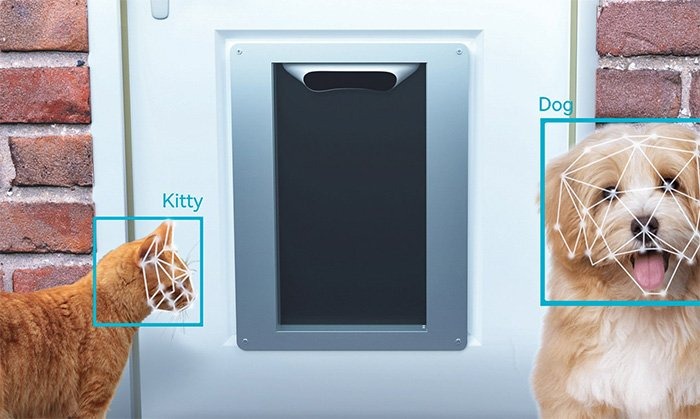
Smart Homes for Pets: Automated Feeders, Doors, and More.
As smart home technology advances, pets are becoming full beneficiaries of automation and AI, enjoying personalized care through devices like automated feeders, microchip-enabled doors, smart collars, cameras, and interactive robots. These innovations not only ensure safety, health, and comfort but also strengthen the bond between pets and owners, transforming modern homes into intelligent, pet-friendly environments.
🐶 Pet Star
60 min read · 23, Oct 2025

Introduction: The Dawn of Pet-Friendly Smart Living
In today’s rapidly evolving digital landscape, the concept of a “smart home” has moved far beyond controlling lights and thermostats with a voice command. Now, technology is stepping into one of humanity’s most cherished domains — pet care. As pet ownership continues to grow globally, so does the demand for innovative solutions that ensure the safety, comfort, and health of our furry, feathered, or even scaly companions.
From automated feeders that ensure perfect portion control to pet doors that unlock only for your dog or cat’s unique microchip, smart homes are making pet care more efficient and reliable than ever before. The integration of artificial intelligence (AI), Internet of Things (IoT), and app-based monitoring systems has allowed pet owners to stay connected with their animals 24/7 — even from thousands of miles away.
This article delves deep into the fascinating world of smart pet technology, exploring the latest innovations, benefits, and challenges in creating homes designed to cater equally to both humans and their beloved pets.
1. Automated Pet Feeders: Feeding Smarter, Not Harder
Feeding pets on time has always been a challenge for busy pet parents. Enter the automated pet feeder — a device that dispenses the right amount of food at the right time, even when you’re not home.
Modern smart feeders come equipped with Wi-Fi connectivity, cameras, voice integration, and AI-based portion controls. For instance, brands like PetSafe Smart Feed and WOPET SmartFeeder allow owners to schedule multiple feeding times, customize portions based on the pet’s dietary needs, and even record their voice to call their pet during mealtime.
Some advanced models now feature weight sensors and RFID-tag detection, ensuring that only the intended pet gets the food. This is particularly useful in multi-pet households where one animal might overeat while another barely gets a bite.
Moreover, integration with smartphone apps allows real-time monitoring. Pet parents can receive notifications when the feeder is low on food, ensuring their furry friend never goes hungry. With smart feeders, nutrition management becomes effortless, reducing the risks of obesity or underfeeding.
2. Smart Pet Doors: Freedom with Security
Traditional pet doors often pose problems — stray animals entering the home, weather exposure, or pets wandering off unsupervised. Smart pet doors have revolutionized this by integrating microchip recognition, collar sensors, and AI monitoring to ensure that only authorized pets can enter or exit.
For example, the SureFlap Microchip Pet Door reads a pet’s embedded microchip or RFID collar tag, automatically unlocking for recognized pets. Similarly, MyQ Pet Portal combines security cameras, motion sensors, and app control, allowing owners to remotely open or close the door.
Some high-end models even have curfew modes, automatically locking at set times to keep pets safely indoors at night. Others include weather-sealing mechanisms and infrared detection, ensuring energy efficiency and safety.
These systems offer the perfect balance between freedom and protection, enabling pets to explore while giving owners complete peace of mind.
3. Smart Collars and Trackers: Keeping Tabs on Every Tail Wag
Losing a pet is every owner’s nightmare, but smart technology has drastically reduced that risk. GPS-enabled smart collars such as Fi Collar, Whistle Go Explore, and Tractive GPS provide real-time tracking of pets via smartphone apps.
Beyond simple location tracking, modern collars now monitor health and behavior patterns. They can detect changes in activity levels, sleep cycles, or heart rate, which may indicate stress, anxiety, or illness. Some even use AI to recognize specific activities like scratching, walking, or running, providing insights into a pet’s daily well-being.
Additionally, geofencing technology allows owners to create virtual boundaries. If a pet strays beyond the designated area, the owner receives instant alerts — ensuring quick recovery and enhanced safety.
As these devices evolve, they are becoming an integral part of preventive pet healthcare, helping veterinarians and owners detect problems before they escalate.
4. Smart Cameras and Treat Dispensers: Staying Connected, Anytime
For working pet parents, smart cameras with treat dispensers are a game-changer. Devices like Furbo Dog Camera and Petcube Bites 2 let owners monitor, talk to, and even reward their pets remotely.
Equipped with HD video, two-way audio, and motion detection, these gadgets allow real-time interaction. Pet owners can toss treats via the app, take snapshots, and even receive alerts if their pet is barking excessively — potentially signaling stress or intrusion.
Some models are now AI-enhanced, identifying specific behaviors such as jumping, pacing, or resting, and sending tailored updates. This kind of emotional connection bridges the gap between pets and owners, especially in long-distance or full-time work situations.
5. Automated Litter Boxes and Waste Systems
Cleaning up after pets is one of the least enjoyable tasks of ownership. Thankfully, automation has stepped in here too.
Smart litter boxes, like Litter-Robot 4 and PetKit Pura X, automatically detect when a cat has used the box, clean the waste, and seal it in a separate compartment to control odor. These devices can also track usage frequency, providing valuable data about a cat’s urinary or bowel health — early indicators of illness.
For dogs, automatic waste collection systems and sensor-enabled potty pads are emerging, making hygiene maintenance easier for urban pet owners living in apartments.
6. Climate Control and Comfort Systems for Pets
Temperature regulation is crucial for pets, especially those sensitive to heat or cold. Smart thermostats like Nest or Ecobee can now integrate with pet comfort sensors, adjusting indoor temperature when your pet is alone.
Some pet-specific solutions include smart cooling mats, heated beds, and ventilated crates that automatically respond to changes in ambient temperature. These devices ensure your pet stays comfortable year-round, preventing dehydration, heatstroke, or chills.
7. AI-Powered Pet Companions and Robots
One of the most futuristic aspects of pet tech is AI-driven robots that can entertain, train, or monitor pets. Robots like Varram Pet Fitness Robot or Ebo Catpal move autonomously, playing interactive games, tossing treats, or capturing video footage.
These robots are especially beneficial for mental stimulation and reducing loneliness in pets left alone for extended periods. Some even respond to a pet’s mood or vocal cues using AI, creating an adaptive, engaging environment.
As AI becomes more sophisticated, such robots may soon evolve into virtual companions, capable of learning a pet’s personality, preferences, and habits.
8. Health Monitoring Systems: From Vets to Virtual Care
Smart health tracking has moved beyond wearable collars to integrated monitoring systems. Devices like Animo Activity Tracker or PetPace Smart Collar collect biometric data such as pulse, temperature, and respiration rate.
Through connected apps, veterinarians can analyze the data remotely, enabling preventive healthcare and early diagnosis. Some systems even integrate with tele-vet platforms, allowing virtual consultations in real time.
In the near future, AI may predict potential health issues such as arthritis, obesity, or diabetes before symptoms appear — making pet care more proactive than reactive.
9. Smart Pet Entertainment: Music, Games, and Enrichment
Entertainment and mental stimulation are vital for pet well-being. Devices like CleverPet Hub use interactive puzzles and light games to reward problem-solving, improving cognitive skills in dogs.
Meanwhile, streaming platforms like Spotify’s Pet Playlists and RelaxMyCat provide audio environments designed to reduce anxiety when pets are home alone. Smart toys like WickedBone or GoBone automatically move, chase, and adapt to a pet’s energy levels, creating a sense of companionship even in solitude.
10. Integration with Voice Assistants and Smart Ecosystems
Smart pet tech becomes truly powerful when integrated into a home automation ecosystem. Devices now connect with Amazon Alexa, Google Home, or Apple HomeKit, enabling seamless control.
For example, you can say, “Alexa, feed Max,” and your smart feeder will dispense food instantly. Similarly, “Hey Google, open the pet door,” allows your dog to step out while you’re cooking.
Such integration not only simplifies tasks but creates an intuitive, connected environment where both human and pet needs are automatically managed.
11. The Environmental and Ethical Dimension
As we embrace smart pet technologies, sustainability and ethical considerations must follow. Many modern devices use eco-friendly materials, energy-saving modes, and biodegradable waste systems.
Moreover, AI and IoT companies are focusing on data privacy — ensuring pet data, like location and health stats, are securely encrypted. Ethical AI use also ensures that technology enhances, rather than replaces, the natural bond between pets and humans.
12. Challenges and the Future of Smart Pet Homes
While the benefits are undeniable, there are challenges too:
- Cost barriers: Many devices remain expensive.
- Technical limitations: Connectivity issues or app malfunctions can disrupt care routines.
- Dependency concerns: Over-reliance on automation may reduce personal interaction.
However, as technology becomes more accessible and affordable, the future of smart pet homes looks promising. Expect upcoming trends such as AI-driven emotional recognition, biometric doors, and predictive health analytics that will redefine what it means to care for a pet.
In the modern digital age, technology is no longer limited to serving human convenience; it has now extended its reach into the world of pets, revolutionizing how we care for and interact with our beloved companions. The concept of a “smart home” has evolved to include intelligent systems that not only make daily life easier for people but also enhance the quality of life for their furry, feathered, or even scaled friends. From automated feeders that ensure perfect meal schedules to smart doors that grant pets safe freedom, smart homes for pets are transforming pet care into a seamless, data-driven, and emotionally connected experience. The journey begins with automated feeders, which have emerged as a boon for busy pet parents who struggle to maintain consistent feeding times. These smart devices dispense precise portions at scheduled intervals, often managed through smartphone apps. Many, like the PetSafe Smart Feed or WOPET SmartFeeder, even feature built-in cameras, voice recorders, and AI-driven portion control systems that adjust food quantities according to your pet’s diet or weight. For households with multiple pets, advanced models come equipped with RFID recognition or microchip scanning, ensuring only the intended pet receives its meal, thus preventing overeating or food stealing. Smart feeders also send real-time notifications when food levels are low, guaranteeing that pets are never left hungry, even when their owners are away. Equally transformative are smart pet doors, which have replaced traditional flaps with secure, microchip-enabled systems that allow only authorized pets to enter or exit. Brands like SureFlap and MyQ Pet Portal use RFID or app-based access, combining motion sensors, cameras, and even curfew settings that automatically lock at night. These innovations offer pets the freedom to move around safely while keeping unwanted animals or intruders out, striking a perfect balance between security and convenience. Complementing these systems are smart collars and trackers, which act as wearable guardians for pets. Equipped with GPS, health sensors, and AI analytics, these collars not only pinpoint a pet’s location in real time but also track activity levels, sleep patterns, and even vital signs such as heart rate and temperature. Devices like Fi Collar and Whistle Go Explore can detect changes in behavior, signaling early signs of illness or stress. Geofencing features further allow owners to set safe zones, sending instant alerts if a pet wanders off. For pet owners who spend long hours at work, smart cameras and treat dispensers like Furbo Dog Camera and Petcube Bites have become invaluable tools. These gadgets offer high-definition live video, motion alerts, and two-way audio so owners can talk to their pets or toss treats remotely. Advanced versions use AI to recognize barking, meowing, or restlessness, sending alerts that help address anxiety or emergencies in real time. Moving on to hygiene and health, automated litter boxes such as Litter-Robot 4 and PetKit Pura X are reshaping cat care by automatically detecting waste, cleaning the box, and sealing odor, while also tracking usage patterns to monitor urinary health. For dogs, smart potty systems and sensor-based pads are making urban pet parenting more manageable. In terms of comfort, smart climate systems have become a crucial addition to pet-friendly homes. Smart thermostats like Ecobee or Nest can link with pet sensors to adjust temperature automatically when pets are alone, ensuring they remain comfortable in extreme weather. Moreover, specialized cooling mats, heated beds, and ventilated crates now respond dynamically to environmental changes, safeguarding pets from heatstroke or hypothermia. Another futuristic leap comes with AI-powered pet robots such as Varram Pet Fitness Robot and Ebo Catpal, which keep pets active and mentally stimulated by playing interactive games, tossing treats, or moving autonomously to engage their curiosity. These robotic companions can even detect a pet’s mood through voice or movement patterns and adjust their behavior accordingly, reducing loneliness when owners are away. Health monitoring has also entered the digital era through smart health tracking systems like PetPace and Animo, which continuously gather biometric data such as respiration, pulse, and temperature. Linked with veterinary apps, these insights enable proactive healthcare and even remote consultations, detecting issues like obesity, arthritis, or stress before they become serious. Meanwhile, smart entertainment tools like CleverPet Hub or WickedBone provide mental stimulation by offering puzzles, games, and interactive movement that keeps pets cognitively sharp. Music streaming platforms like Spotify’s Pet Playlists or RelaxMyCat are now scientifically curated to calm pets’ anxiety, further enhancing their emotional well-being. Integration across platforms is another hallmark of smart pet homes — today, many devices are compatible with Amazon Alexa, Google Home, and Apple HomeKit, enabling owners to manage feeding, temperature, lighting, and more with simple voice commands like “Alexa, feed Bella” or “Hey Google, open the pet door.” Such interconnected systems are creating unified environments where human and pet routines coexist in harmony. However, while these innovations promise convenience and better care, they also raise important questions about cost, privacy, and dependence. Smart devices can be expensive initially, and constant connectivity means owners must stay aware of cybersecurity risks to protect data related to their pets’ location or health. Moreover, experts caution against over-reliance on automation; while technology can supplement care, it should never replace the human affection and emotional connection that pets thrive on. Encouragingly, developers are addressing these concerns with eco-friendly materials, energy-efficient systems, and ethical AI standards that emphasize safety and sustainability. Looking ahead, the future of smart pet homes points toward even greater sophistication — AI that understands pets’ emotional states, predictive health analytics that forecast potential diseases, and fully integrated systems that respond to pets’ movements, moods, and habits in real time. Ultimately, smart pet technologies reflect a broader cultural shift: our pets are no longer just animals we care for, but family members whose well-being deserves the same technological attention we devote to ourselves. Smart homes for pets represent not just convenience, but compassion enhanced by innovation — ensuring that every bark, purr, and wag receives the love, safety, and attention it deserves, even in our increasingly fast-paced world.
In the rapidly advancing digital era, smart home technology has extended far beyond human convenience and is now revolutionizing the way we care for our pets, creating an environment where automated systems, artificial intelligence, and the Internet of Things (IoT) work together to ensure the safety, health, comfort, and happiness of furry, feathered, and even scaled companions, with innovations ranging from automated feeders that provide precise nutrition at scheduled intervals, smart doors that allow only authorized pets to enter or exit through microchip or RFID recognition, to wearable smart collars and trackers that monitor location, activity levels, and vital signs in real time, and cameras integrated with treat dispensers that let owners interact with pets remotely while addressing loneliness or anxiety; automated feeders like the PetSafe Smart Feed and WOPET SmartFeeder not only dispense food at the right times but also allow voice recordings, portion control, and scheduling through smartphone apps, while advanced models with RFID detection prevent one pet from stealing another’s meal, making feeding both precise and hygienic, and notifications sent via apps ensure pet owners never run out of food even when away from home, supporting balanced diets and preventing obesity or underfeeding; similarly, smart pet doors from brands like SureFlap or MyQ Pet Portal provide secure freedom for pets by only unlocking for microchip-recognized animals, with curfew modes, weather-resistant designs, and integration with smartphone apps to remotely control access, ensuring pets can safely explore outdoors without the risk of intrusion from stray animals or exposure to extreme weather; smart collars like Fi, Whistle Go Explore, and Tractive GPS offer GPS tracking, geofencing, activity monitoring, and health metrics such as heart rate, sleep patterns, and respiratory rate, allowing pet owners to detect behavioral changes or potential health issues early, while AI-driven insights identify patterns in movement or stress and provide actionable information for preventive care, thereby bridging the gap between pets and owners who are away for work or travel; additionally, smart cameras like Furbo Dog Camera and Petcube Bites 2 combine HD video, two-way audio, motion detection, and treat dispensers, allowing owners to see, talk to, and interact with their pets remotely, which reduces separation anxiety and helps maintain emotional bonds, and AI-powered alerts for barking or unusual activity provide real-time updates to address behavioral or emergency situations; hygiene and waste management have also been transformed, with smart litter boxes like Litter-Robot 4 and PetKit Pura X automatically cleaning waste, sealing odors, and tracking usage patterns that can indicate urinary or digestive health issues in cats, while sensor-based potty pads and automatic waste collection systems simplify dog care in urban environments, minimizing mess and maintaining home cleanliness; climate control for pets is another innovation, with smart thermostats such as Nest and Ecobee linked to pet sensors to regulate indoor temperature automatically, ensuring comfort during extreme heat or cold, while specialized products like heated beds, cooling mats, and ventilated crates respond to ambient conditions to protect pets from temperature-related stress or illness, contributing to overall well-being; beyond basic care, AI-powered robotic companions such as Varram Pet Fitness Robot and Ebo Catpal engage pets with games, movement, and treat dispensing, responding to the pet’s mood or vocalizations and providing interactive stimulation that reduces boredom and supports mental health, particularly for pets left alone for extended periods; smart health monitoring systems like Animo Activity Tracker and PetPace Smart Collar collect biometric data including pulse, temperature, and respiration, feeding the information to apps that allow veterinarians to analyze health remotely, enabling early intervention for potential conditions such as obesity, arthritis, anxiety, or cardiovascular issues, and some systems even integrate tele-vet services for virtual consultations; entertainment technology is evolving as well, with interactive devices like CleverPet Hub and WickedBone providing problem-solving games and adaptive challenges that enhance cognitive development, while music and audio platforms like Spotify Pet Playlists or RelaxMyCat are designed to calm pets, reduce anxiety, and provide mental stimulation, creating an enriched environment for emotional well-being; integration of these devices with broader smart home ecosystems via Amazon Alexa, Google Home, or Apple HomeKit allows for seamless control of multiple functions, including voice-activated feeding, door access, temperature adjustments, and even entertainment, resulting in a connected environment where both human and pet needs are anticipated and met automatically; sustainability and ethical considerations are increasingly central to these technologies, with many devices using eco-friendly materials, energy-efficient operation, and secure data encryption to protect pets’ health, location, and activity information; however, challenges remain, including affordability, potential over-reliance on automation, technical glitches, and ensuring that technology complements rather than replaces human affection, but despite these limitations, the future of smart pet homes is promising, with developments on the horizon such as AI capable of detecting emotional states, predictive health analytics that anticipate illness before symptoms appear, fully integrated systems that adapt dynamically to a pet’s behavior and preferences, and increasingly intelligent robotic companions that interact in lifelike ways, ultimately reflecting a society that values pets not only as companions but as family members deserving of tailored, technologically enhanced care, ensuring every aspect of their daily lives from nutrition, exercise, and hygiene to mental stimulation and emotional security is managed thoughtfully, effectively, and with a degree of personalization and intelligence that traditional pet care alone could never achieve, making smart homes for pets a revolutionary step in modern animal welfare and human-pet relationships, blending compassion with technology to create environments where pets are safer, healthier, happier, and more connected to their owners than ever before.
Conclusion
The evolution of smart homes for pets represents a groundbreaking shift in the way humans care for their animal companions. From automated feeders to AI-powered robots, technology is making pet parenting easier, safer, and more connected than ever before.
Smart devices not only enhance convenience but also provide deeper insights into pet behavior and health, transforming everyday care into a data-driven, emotionally intelligent experience.
As these innovations continue to evolve, they promise a future where our homes will understand and respond to our pets’ needs — ensuring every wag, purr, or chirp is met with the love and care it deserves.
Q&A Section
Q1:- What are smart pet devices?
Ans:- Smart pet devices are tech-powered tools that automate and enhance pet care through features like remote feeding, tracking, monitoring, and interaction using AI, IoT, and mobile apps.
Q2:- How do automated pet feeders work?
Ans:- Automated pet feeders dispense scheduled portions of food at set times. Some use Wi-Fi connectivity and smartphone apps to allow remote feeding, portion control, and monitoring.
Q3:- Are smart pet doors safe?
Ans:- Yes. Smart pet doors use microchip or RFID recognition to allow entry only to authorized pets, ensuring security against strays or intruders.
Q4:- What are the benefits of using smart collars?
Ans:- Smart collars provide GPS tracking, health monitoring, and activity tracking, allowing owners to ensure their pet’s safety and well-being in real time.
Q5:- Can smart cameras help reduce pet anxiety?
Ans:- Yes. Smart cameras with two-way audio and treat dispensers allow interaction, reducing loneliness and anxiety when pets are home alone.
Similar Articles
Find more relatable content in similar Articles

How Climate Change Affects Wild and Domestic Animals...
Climate change is dramatically.. Read More

Sustainable Pet Products: What to Look for in 2025...
As sustainability becomes a ce.. Read More

Smart Homes for Pets: Automated Feeders, Doors, and Mo..
As smart home technology advan.. Read More

How Pets Strengthen Family Bonds...
Pets are more than just compan.. Read More
Explore Other Categories
© 2024 Copyrights by rPets. All Rights Reserved.